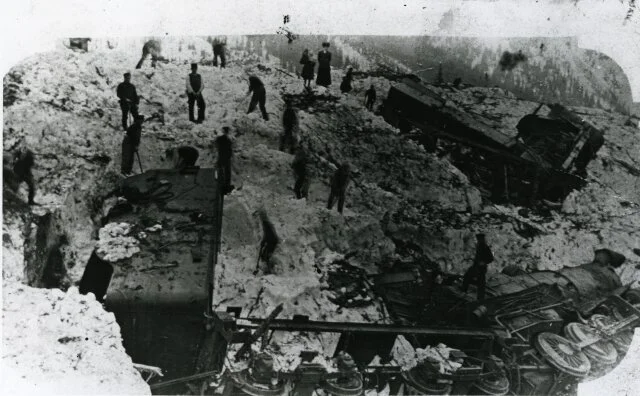Remembering the 1910 Rogers Pass Snowslide
Today, March 4, 2020, marks the 110th anniversary of the largest avalanche event in Canada, in terms of loss of life. The Rogers Pass snowslide took the lives of 58 men, and the tragedy continues to resonate, especially here in the mountains, where the risk of avalanches is still a common threat for travellers and back-country enthusiasts.
Before the construction of the Connaught Tunnel, which bypassed some of the most treacherous avalanche terrain, avalanches were a constant threat. Snowsheds were built over some of the known avalanche paths, but there were still areas where the terrain was unstable, and travelers and railway workers were in danger. On March 4, a slide came down from Mount Cheops and buried the track at the summit of Rogers Pass. A crew was sent out to clear the tracks and they were making good progress. Just before midnight, road master John Anderson walked east to the nearest call box and reported to Revelstoke that the slide was almost cleared. He came back to discover that a second slide had come from the opposite side of the valley, off the slopes of Avalanche Mountain, burying his crew.
Writing about the event later, he said, “When I returned I found everything buried. I found the Rotary pitched on top of the shed. Everything was in darkness and the wind blowing hard and 58 men buried in the slide…I lost my brother Charlie.”
The 58 victims were Canadian, Japanese, English, Irish, Scottish, Swedish, Danish, and Ukrainian. Some had lived in Canada for generations, and some were more recent immigrants. They were foremen, bridgemen, engine crew, and labourers. They were as young as 19 and as old as 48. All of them left family behind – wives, children, parents, siblings – in Revelstoke, across Canada, in Europe and Japan.
Clearing out after the Rogers Pass snowslide of March 4, 1910
Of the 58 victims, 32 were Japanese workers in the employ of the Canadian Nippon Supply Company, who provided contract labourers to the CPR and other employers. The majority of them had come to Canada early in the century in search of work. Some had left all of their family back in Japan, while others had relatives in Vancouver. All of the Japanese victims were sent to Vancouver, and they are all buried in Mountain View Cemetery. Thanks to the dogged research of Tomoaki Fujimura of Revelstoke, we know quite a bit about most of these men.
There are so many different stories associated with this one event. There is the remarkable story of Bill Lachance, a railway fireman who was thrown about in the avalanche, but survived. For years, he was referred to as the sole survivor, but Tomoaki’s research in Japanese newspaper sources have revealed that at least two Japanese workers survived as well. There are the 58 individual stories of the men who died. The original CPR documents in the archives at Revelstoke Museum and Archives include letters from families of the men who died, showing the real human impact that this event had on so many people.
Some of the stories around this event are captured on the museum’s virtual exhibit, Land of Thundering Snow, including a time-line showing the March 4 slide as part of a larger storm cycle in the Pacific Northwest. The exhibit also includes a video about the 100th anniversary commemoration of the slide, and shows how people continue to be moved by this story.

